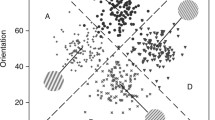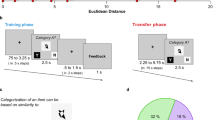Abstract
There is a growing amount of evidence suggesting that individuals with autism have difficulty with categorization. One basic cognitive ability that may underlie this difficulty is the ability to abstract a prototype. The current study examined prototype and category formation with dot patterns in high-functioning adults with autism and matched controls. Individuals with autism were found to have difficulty forming prototypes and categories of dot patterns. The eye-tracking data did not reveal any between group differences in attention to the dot patterns. However, relationships between performance and intelligence in the autism group suggest possible processing differences between the groups. Results are consistent with previous studies that have found deficits in prototype formation and extend these deficits to dot patterns.




Similar content being viewed by others
References
Bott, L., Brock, J., Brockdorff, N., Boucher, J., & Lamberts, K. (2006). Perceptual similarity in autism. The Quarterly Journal of Experimental Psychology, 39, 1–18.
Eigsti, I., & Mayo, J. (2011). Implicit learning in ASD. In D. A. Fein (Ed.), The neuropsychology of autism. New York: Oxford Press.
Frith, U., & Happé, F. (1994). Autism: Beyond “theory of mind”. Cognition, 50, 115–132.
Gadow, K., Sprafkin, J., & Weiss, M. (1999). Adult symptom inventory-4. Stony Brook, NY: Checkmate Plus.
Gastgeb, H. Z., Strauss, M. S., & Minshew, N. J. (2006). Do individuals with autism process categories differently: The effect of typicality and development. Child Development, 77, 1717–1729.
Gastgeb, H. Z., Rump, K. M., Best, C. A., Minshew, N. J., & Strauss, M. S. (2009). Prototype formation: Can individuals with autism abstract facial prototypes? Autism Research, 2, 279–284.
Gastgeb, H. Z., Wilkinson, D. A., Minshew, N. J., & Strauss, M. S. (2011). Can individuals with autism abstract prototypes of natural faces? Journal of Autism and Developmental Disorders, 41, 1609–1618.
Homa, D., Goldhart, B., Burruel-Homa, L., & Smith, J. C. (1993). Influence of manipulated category knowledge on prototype classification and recognition. Memory and Cognition, 21, 529–538.
Kéri, S., Kálmán, J., Kelemen, O., Benedek, G., & Janka, Z. (2001). Are Alzheimer’s disease patients able to learn visual prototypes? Neuropsychologia, 39, 1218–1223.
Klinger, L. G., & Dawson, G. (1995). A fresh look at categorization abilities in persons with autism. In E. Schopler & G. Mesibov (Eds.), Learning and cognition in autism (pp. 119–136). New York: Plenum Press.
Klinger, L. G., & Dawson, G. (2001). Prototype formation in autism. Development and Psychology, 13, 111–124.
Klinger, L. G., Klinger, M. R., & Pohlig, R. L. (2006). Implicit learning impairments in autism spectrum disorders: Implications for treatment. In J. M. Perez, P. M. Gonzalez, M. L. Comi, & C. Nieto (Eds.), New developments in autism: The future is today (pp. 75–102). Kingsley Press: London.
Knowlton, B. J., & Squire, L. R. (1993). The learning of categories: Parallel brain systems for item memory and category knowledge. Science, 262, 1747–1749.
Lewis, P., & Strauss, M. S. (1986). Infant concept development. In G. Whitehurst (Ed.), Annals of child development. Connecticut: J. A. I. Press.
Lord, C., Rutter, M., Goode, S., Heemsbergen, J., Jordan, H., Mawhood, L., et al. (1989). Autism diagnostic observation schedule: A standardized observation of communicative and social behavior. Journal of Autism and Developmental Disorders, 19, 185–212.
Lord, C., Rutter, M., & Le Couteur, A. (1994). Autism diagnostic interview-revised: A revised version of a diagnostic interview for caregivers of individuals with possible pervasive developmental disorders. Journal of Autism and Developmental Disorders, 24, 659–695.
Minshew, N. J., Goldstein, G., Muenz, L. R., & Payton, J. B. (1992). Neuropsychological functioning in non-mentally retarded autistic individuals. Journal of Clinical and Experimental Neuropsychology, 14, 749–761.
Minshew, N. J., Meyer, J., & Goldstein, G. (2002). Abstract reasoning in autism: A dissociation between concept formation and concept identification. Neuropsychology, 16, 224–327.
Molesworth, C. J., Bowler, D. M., & Hampton, J. A. (2005). The prototype effect in recognition memory: Intact in autism? Journal of Child Psychology and Psychiatry, 46, 661–672.
Molesworth, C. J., Bowler, D. M., & Hampton, J. A. (2008). When prototypes are not best: Judgments made by children with autism. Journal of Autism and Developmental Disorders, 38, 1721–1730.
Mottron, L., Dawson, M., Soulières, I., Hubert, B., & Burack, J. (2006). Enhanced perceptual functioning in autism: An update, and eight principles of autistic perception. Journal of Autism and Developmental Disorders, 36, 27–43.
Newell, L. C., Best, C. A., Gastgeb, H., Rump, K. M., & Strauss, M. S. (2010). The development of categorization and facial knowledge: Implications for the study of autism. In L. M. Oakes, C. H. Cashon, M. Casasola, & R. H. Rakison (Eds.), Infant perception and cognition: Recent advances, emerging theories, and future directions. Oxford Press: New York.
Oakes, L. M., Cashon, C. H., Casasola, M., & Rakison, D. H. (Eds.). (2010). Infant perception and cognition: Recent advances, emerging theories, and future directions. New York: Oxford University Press.
Plaisted, K., O’Riordan, M., & Baron-Cohen, S. (1998). Enhanced discrimination of novel, highly similar stimuli by adults with autism during a perceptual learning task. Journal of Child Psychology and Psychiatry, 39, 765–775.
Posner, M. I., & Keele, S. W. (1968). On the genesis of abstract ideas. Journal of Experimental Psychology, 77, 353–363.
Posner, M. I., Goldsmith, R., & Welton, K. E. (1967). Perceived distance and the classification of distorted patterns. Journal of Experimental Psychology, 73, 28–38.
Rosch, E., & Lloyd, B. (1978). Cognition and categorization. Hillsdale NJ: Lawrence Erlbaum Associates.
Rubenstein, A. J., Kalakanis, L., & Langlois, J. H. (1999). Infant preferences for attractive faces: A cognitive explanation. Developmental Psychology, 35, 848–855.
Strauss, M. S. (1979). The abstraction of prototypical information by adults and 10 month old infants. Journal of Experimental Psychology: Human Learning and Memory, 50, 618–632.
Vladusich, T., Olu-Lafe, O., Kim, D.-S., Tager-Flusberg, H., & Grossberg, S. (2010). Prototypical category learning in high-functioning autism. Autism Research, 3, 1–11.
Wechsler, D. (1999). Wechsler abbreviated scale of intelligence. San Antonio: The Psychological Corporation.
Weissman, M. M., Wickramaratne, P., Adams, P., Wolk, S., Verdeli, H., & Olfson, M. (2000). Brief screening for family psychiatric history: The family history screen. Archives of General Psychiatry, 57, 675–682.
Younger, B. (1990). Infant categorization: Memory for category-level and specific item information. Journal of Experimental Child Psychology, 50, 131–155.
Younger, B., & Gotlieb, S. (1988). Development of categorization skills: Changes in the nature or structure of infant form categories. Developmental Psychology, 24, 611–619.
Zaki, S. R., & Nosofsky, R. M. (2007). A high-distortion enhancement in the prototype-learning paradigm: Dramatic effects of category learning during test. Memory & Cognition, 35, 2088–2096.
Acknowledgments
This study was supported by NIH/NICHD HD055748 and PA Department of Health SAP # 4100047862. The results presented here were submitted by Holly Zajac Gastgeb as part of her Ph.D. dissertation (Department of Psychology, University of Pittsburgh). We are grateful to Dr. Catherine Best, Dr. Keiran Rump, Sarah Hannigen, Desirée Wilkinson, Sara Green, and Kao-Wei Chua for testing participants involved in the current study and Dr. Carla Mazefsky for commenting on prior versions of the manuscript.
Author information
Authors and Affiliations
Corresponding author
Rights and permissions
About this article
Cite this article
Gastgeb, H.Z., Dundas, E.M., Minshew, N.J. et al. Category Formation in Autism: Can Individuals with Autism Form Categories and Prototypes of Dot Patterns?. J Autism Dev Disord 42, 1694–1704 (2012). https://doi.org/10.1007/s10803-011-1411-x
Published:
Issue Date:
DOI: https://doi.org/10.1007/s10803-011-1411-x




